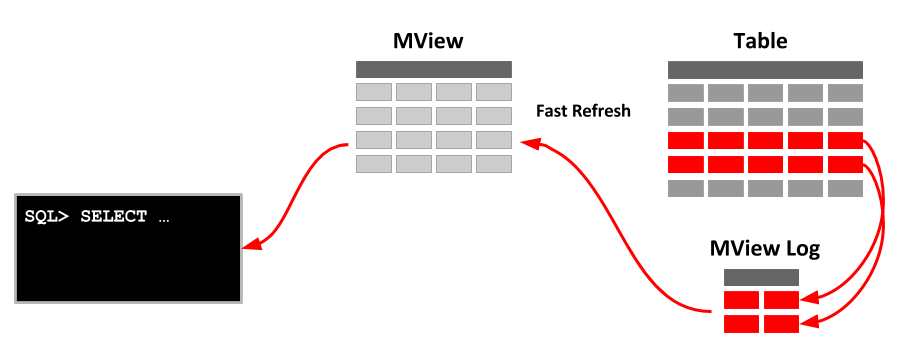View is made by ‘Create View’ command and is a virtual table. View, the virtual data have the data extracted from the query expression in the ‘Create View’ command. A “view” can be made from one or more basic views or tables. Views can be questioned when you query the unique base table.
Materialized View is a photo or physical copy or snapshot of the unique base tables. Same as ‘View’, materialized view contains the data extracted from the question expression of the ‘Create Materialized View’ command. It requires a manual update if you want to save changes with a trigger known as Materialized View Maintenance.
Difference between Materialized View and View

Views are used for virtual projections of the output query results. They provide a dynamic view of the data available in the database for use by those who issue query expressions. On the other hand, materialized views are best described as non-virtual schemas and relate to database storage. Materialized views are mainly used for pre-computing, aggregating, reproducing and spreading data.
| View | Materialized View | |
| Cost | Because a view has no associated storage price, it doesn’t have an associated update price either. | Materialized views, on the other hand, have an associated storage price, so they also have a recent price associated with it. |
| Storage | In ‘View’, the resulting tuples from the query expression are not stored on disk; only query expressions are stored on disk. | On the other hand, in the case of materialized views, the query expressions and the resulting tuples are stored on a disk. |
| Use | Views are usually used when data is rarely used and table data is frequently updated. | On the other hand, a material view is used when the data needs to be accessed frequently and the data in the table is not updated frequently. |
| Execution of Query | As noted above in the view case, the query expression is saved to disk, not the result, so the query expression is executed every time the user tries to get data from it, so that the user gets the latest updated value every time. | On the other hand, with materialized views, query results are stored on disk and therefore query expressions are not executed every time the user tries to get data, so the user does not get the latest update values when database changes are made. |
| Style | Views in SQL are designed with a fixed architectural approach, which is why there is a SQL standard for defining views. | On the other hand, in the case of embodied views, SQL is designed with a general architectural approach, so there is no SQL standard to define it, and its functionality is provided as an extension by some database systems. |
| Refresh view | Refresh view updated whenever a virtual table (view) is used. | The materialized view has to be updated manually or with the help of triggers. |
| Syntax | Take a look at the View syntax
Create view V as <query expression> |
Take a look at the Materialized view syntax:
Creating V Realized Views Build [clause] update [type] ACTIVE [activation] As <query expression> |
| References per line
|
When a view is created with any table, the rows ids of the view are the same as the rows ids of the original table. | While with materialized views when row id is created, materialized views are completely different. |
| Result | The view uses the output of each query to look like a virtual table. | The materialized view lies in the nature of the subject of regulation. Used for dissemination, reproduction, pre-computation, and data aggregation. For example, to set up a data warehouse. |
| Speed | The overall performance of the View is slower than that of the Materialized View because the View is not saved to disk. | Whereas the material view is saved to disk, making it easier for users to easily access the latest updated database and therefore high performance. |
| Method of use | The display is virtual or logical storage based on selected options. | Materialized views provide access to duplicate physical data in separate tables. It works as a data snapshot, is faster than normal tables and can be used for security reasons. |
Conclusion
View always provides users with up-to-date information. However, Materialized views are more responsive than views. It is important to know the concepts of views and materialized views, and differences regardless of whether you are a SQL user or programmer, or developer. If you have other thoughts on materialized views versus views, we’d love to hear from you. Leave your comments in the comments section below.
The post Materialized View vs View – Know the Difference appeared first on The Crazy Programmer.
from The Crazy Programmer https://ift.tt/3DXlEfL
Comments
Post a Comment